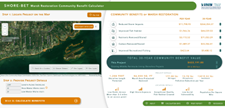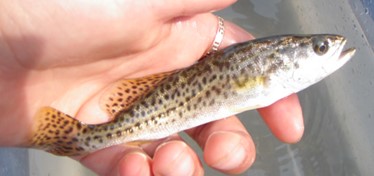Ecosystem Service Values
VALUING THE BENEFITS PROVIDED BY MARSHES AND LIVING SHORELINES TO COASTAL COMMUNITIES

Coastal and estuarine marsh habitats provide important benefits to coastal communities. These benefits, such as carbon storage, nutrient removal, fish habitat provision, recreation opportunities, aesthetics, and reduction in storm damages, are often referred to as ecosystem services. Changing climate conditions and human stressors are threats to marsh habitats and their ability to provide valued services. The increasing rate of sea level rise is causing increased marsh migration and loss (Mitchell et al. 2017). Loss of marsh habitat is especially prevalent in areas where marsh migration pathways are limited.
Coastal development and hard shoreline modification for erosion control, such as the installation of bulkheads and revetments, lead to the reduction of natural resilience and adaptive capacity of coastal environments (Sutton-Grier et al. 2015). In order to prevent erosion while still protecting the resiliency of coastal environments, nature-based solutions may be utilized. Nature-based coastal protection approaches that restore or protect salt marsh as a means to reduce erosion and storm damage (living shorelines henceforth) can help mitigate some of the anticipated loss or degradation of marshes from climate and anthropogenic stressors, in particular sea level rise. For additional information about living shorelines, please visit: https://www.vims.edu/ccrm/outreach/living_shorelines/
Understanding and communicating the value of coastal and estuarine marsh ecosystem services can help with shoreline management and restoration decisions because one can evaluate tradeoffs of different interventions, such as is there greater community benefit to restoring a marsh in one location or another. Restoration decisions often are made at more local scales, requiring interdisciplinary ecosystem service valuation approaches that can reflect local conditions and human perceptions and values. Spatial variation in ecosystem service values arises from both differences in site-dependent ecosystem function and processes, as well as differences in human use and preferences (De Valck and Rolfe 2017).
We combined economic valuation techniques with human use and preference surveys, local ecological function data, and physical and geospatial modeling to estimate the value and spatial variation in ecosystem service benefits for marsh and living shorelines within understudied rural coastal communities in Chesapeake Bay, Virginia, USA.
This Study
- Estimated the monetary value of ecosystem service benefits provided by marshes & living shorelines for local communities in the Middle Peninsula, Virginia.
- Developed an interactive web-based tool, SHORE-BET: MARSH RESTORATION COASTAL COMMUNITY BENEFIT TOOL, that calculates gained ecosystem and community benefits for marsh restoration projects. This tool is intended to support planning, reporting, and restoration prioritization.
Key Findings
- Total ecosystem service benefits equaled ~$87.6M per year
- The highest value is attributed to storm risk reduction benefits provided by marshes and community partners ranked this service to be most highly valued
- Marsh and living shoreline habitats are the most used and highest value by recreational fishers than any other shoreline habitat
- Living shorelines generate more than 3X the value for anglers than armored shores

SHORE-BET- Marsh Restoration Community Benefit Calculator

Ecosystem Benefits Map Viewer

Ecosystem benefits of marshes and living shorelines

Recreational Fisher Habitat Use

Publications, Media, & Resources

Project Fact Sheet
PROJECT TEAM:
Investigators: VIMS - Donna Marie Bilkovic, Andrew Scheld, Jessica Hendricks, Pam Mason, Susanna Musick, Robert Isdell, Molly Mitchell, Sean Gregory, CBNERR - Cirse Gonzalez; W&M - Randy Chambers, Matthias Leu, Sarah Stafford
Students: W&M - Maddie Helfer, Matthew Whalen, Nhu-Lan Pho, Jessica Fergel, Sophie Jackson, Madelyn Atkins, UVA ERI program - Kathleen Powers, VIMS - Kati Grigsby, Oluwakemi B. Dada, AnnJacob Woodson, Gabe Benson
Community partners: VMRC, DEQ/CZM, CBF, NERRS, Colonial SWCD, MPPDC, DWR, HRPDC, Wetlands Watch, SEAS, Recreational fishers, Master Gardeners, Upper Mattaponi Indian Tribe, CBLP, Master Naturalists, NCBO

This research was supported by The National Oceanic and Atmospheric Administration under Grant Number NA21NMF4570524-T1-01.

